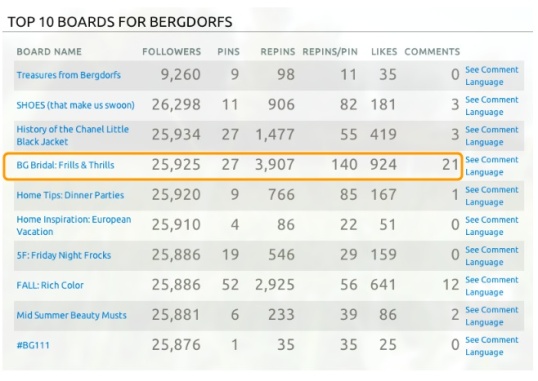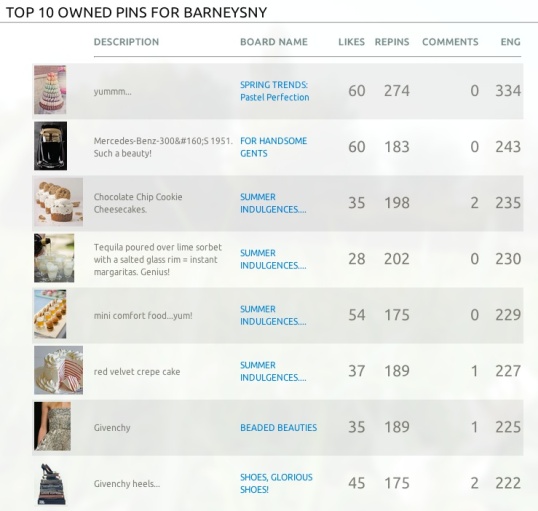Today we’re going to get our hands dirty with some Pinterest data analysis for three top brands and discover some surprising things along the way. As I explained in my last post, Pinterest is not only a great platform for customer engagement and discovery, its also an amazing way to understand how customers think about your products.
For the first in my series on Pinterest insights, I’ll be looking at high-end retailers Barney’s NY, Bergdorf Goodman, and Saks Fifth Avenue.
I’ll be using a “Pinterest Affinity Engine” called Pinfuse for a majority of the analysis. The tool allows me to see high-level metrics, earned/owned Pinterest content, and affinity analysis for a brand and it’s competitive set. But enough talk, let’s dive in!
OVERVIEW:
A quick look at summary metrics for each retailer shows that each brand has created roughly the same volume of owned content (definitions for owned vs earned content, which will be referenced frequently, can be found in the last post. It’s worth going back and reading if this is your first visit!)
The engagement with that content, however, differs wildly by brand. Bergdorf Goodman has much higher engagement across their owned pins, leading the pack with comments, likes, and the all-important repins/pin. Their success with the high levels of engagement is due mostly to their huge follower base, with almost 2x the followers of the closest rival.
Glancing at the high-level metrics, one could be led to think that BG has this game wrapped up, but BG’s high levels of engagement vs the benchmarks (like, comment, and repin counts) hides the true metric that should be measured for success: engagement per follower. The truth is that BG’s repins/follower (.89) is lower than both Saks(1.1) and Barney’s(1.1).
BG has done a great job of building up a follower base that is engaged, but they shouldn’t let their high raw counts of benchmarks lead them to claim victory quite yet. The next step for their team is to leverage this great follower asset by raising engagement per follower to the same levels seen across the industry.
DEMOGRAPHIC ANALYSIS:
A quick check of gender analysis for users that pin content from each brand shows that all three brands skew higher for female representation vs the reported Pinterest average of 85%, with Saks taking the lead with a 98% female (!) audience make-up. With many brands, segmenting the affinity and conversation language by gender can show great insights into differences in preference. With brands that are as far skewed as the above, it will take a good amount more data to get significant findings for gender segmentation.
BOARD-LEVEL ANALYSIS:
When we dive into the board-level analysis, we can see where BG is leading: bridal.
Their “BG Bridal: Frills and Thrills” is seeing a nutty 140 repins per pin average, well ahead of all their other boards (and those of Saks and Barney’s.) BG’s top pins ,which the Pinfuse tool sorts for us, are made up of mostly bridal pins as well.
When we look at the most popular owned pins for Barney’s, something surprising happens…products don’t make many appearances in the top ten.
With Barney’s, it’s the lifestyle content that resonates with customers: cakes, cookies, tequila, cars, and style icons. If this is part of Barney’s strategy for using Pinterest as a brand vehicle, then it’s working, and the other brands on this list could learn from their success.
When we look at the top owned content for Saks, it’s quickly obvious that they have the most diverse list of most popular owned Pinterest content (both top boards and pins.) This isn’t a bad thing – if the Saks team is looking for a more overall brand/shopping experience for users, then they are hitting the mark.
The pins that are resonating most with users are a mix of shoes, dresses, inspirational sayings, jewelry, travel and handbags. Sounds like a perfect trip to Saks for my wife!
EARNED PINS:
The earned pins (content that users find on their own and then pin to their own boards) for all of the high-end retailer brands are made up primarily of shoes, bags, and dresses. As you’ll see in the next section, this is where the core affinity lies for these brands.
One thing I want to note is that the earned pin engagement rates are telling a very different story vs the owned pin engagement rates, which is a pattern I’ve seen with many brands on Pinterest. Repin rates for earned pins are much lower vs owned, with Barney’s (.19 repins/pin) leading both other brands (both at .15 repins/pin.)
While the owned engagement rates show how influential each brand is on Pinterest, the earned engagement rates show the influence of a brand’s users.
AFFINITY ANALYSIS:
The true potential with Pinterest data lies in customer affinity. Once you are able to aggregate and analyze that data, you can answer questions like:
- Do potential customers think of my products as a summer or fall item?
- Is my product something they want vs. need?
- When customers think of my brand, is it because of our food offerings or our drink offerings?
- How emotionally attached are my customers with my brand vs the competition?
The Pinfuse tool was created to answer questions like these. It analyses Pinterest board labels, description and comment text with natural language processing to highlight the top affinity themes for a brand (and it’s competition.) It’s cool stuff – and I’ll show you an example.
Here’s a competitive analysis of the top themes (ranked by frequency) that the Pinfuse algorithms have generated for Bergdorf Goodman, Barney’s and Saks. As you can see above, the top affinity themes don’t change much between the brands: shoes, style, fashion and bags rule how customers think of the three players (albeit in slightly different order.) To get the most value from a competitive affinity analysis, focus not only on the top themes but also on themes that are unique vs. the competition.
For Bergdorf Goodman, it’s “Fall” and “dress.” BG seems to have done a great job in their marketing (on Pinterest and elsewhere) in getting users to associate their brand with the upcoming Fall shopping season (if you’re curious, some of the literal board names where BG is pinned to include “Fall fashion”, “Fall is my birthday – presents?”, and “Fall in love”), while Barney’s and Saks aren’t top of mind in this category with this group of customers.
Barney’s is registering the highest for “jewelry” (which also comes it at the #10 spot for BG, but doesn’t register for Saks) and the aspirational “wish” affinity themes. It’s worth noting that while Barney’s has a few jewelry items on their owned boards, the only jewelry-themed board is from Valentine’s Day. The above view of customer affinity is a great opportunity for Barney’s to understand how their customers are using Pinterest, and create more jewelry-themed boards to encourage more repins, comments, and happy customers.
Saks is seeing more pinners include their products in boards with the more literal label of “clothes” (some of the literal board names here are “a girl can never have enough clothes”, “clothes for baby girl”, and “Clothes and stuff”), which can help guide copywriting on both the Pinterest channel as well as in other channels. In addition, they are also seeing the affinity with the term “want”, which shows great aspirational attachment to their products for many users (and doesn’t appear in the top ten for either of the other brands.)
TURNING PINTEREST LANGUAGE INTO AN ENGAGEMENT MACHINE:
What else can we do with language on Pinterest? One great example is to create lists of users to reach out to based on both advocacy levels and language patterns that they use across boards, descriptions, and comments. Here’s an example for Saks created by Pinfuse with a feature called “Love + Affection”:
This feature identifies each influencer by their language pattern for affectionate themes for the brand through natural language processing. For example, if a pinner writes a description saying “love this!”, pins a Saks item to a board with the name “Products I Absolutely Adore”, or gushes about “how cute” a product is, they are added to a list for the brand’s social media team for outreach. I’ll show you other applications of this technology in future blog posts, it’s a great way of combining advocacy, language, and common sense to reach out to the right customers that are saying wonderful things about you, or self-identifying as hand-raisers for consideration of your products.
CONCLUSION:
Pinterest, as I’ve hopefully demonstrated above, can provide a great amount of insight into how your customers think about your brand and your competition. Measuring engagement on your social media efforts is critical, but don’t overlook the insight opportunities that lie within the data.
For the next analysis, I’ll be looking at major apparel brands on Pinterest. I’ll revisit a few of the analyses above with the new brands, but also dive into gender segmentation and comment language analysis. See you next time!










[…] analyzing data for all different types of brands, my answer is simple: Pinterest makes sense for brands because of […]